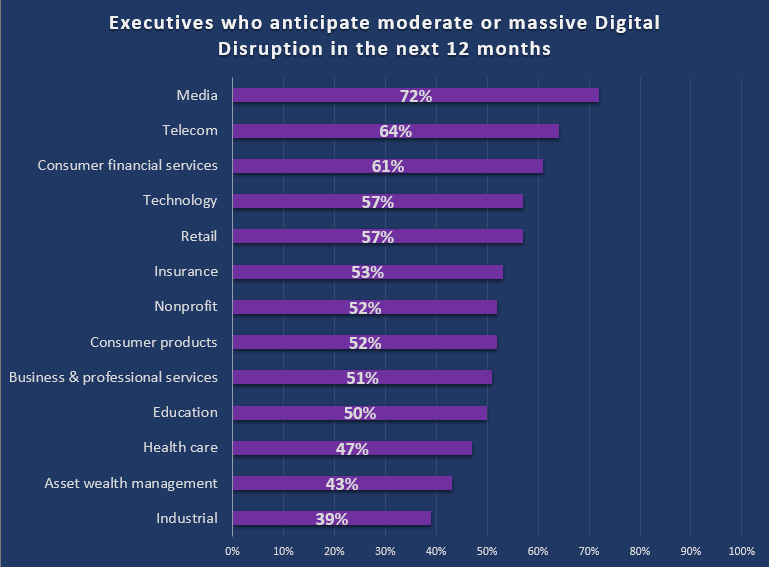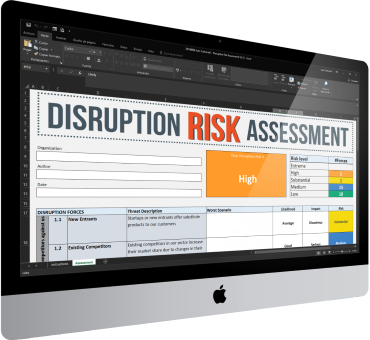Despite the apocalyptic messages that the end of the world is near what I really see is that people hear the messenger, smile sympathetically and continues with their normal life. When they exit from the conference room or close the article they go back to day-to-day business and quickly forget about future problems.
Why?
Because it’s not their responsibility to think about future changes? It’s true that many executives are hired to optimize how the business operates in a certain environment. But if they don’t consider environmental changes, who will do it?
Because disruption only affect a few sectors? Mine is not on the list. Maybe next year.
It’s because disruption have been there for years but we’re still in business. It’s a buzzword used by consultants to create panic and sell their services.
Really there are a lot of excuses. And using some of those excuses we’re able to overcome the nth crisis committee and delay action for a few months or until the next year.
But what many people and businesses fail to realize is that disruption takes place at terrifying speed.
Don’t fail to realize that #disruption takes place at terrifying speed / #Innovation
Click to Tweet
And what many people and businesses fail to acknowledge is that their reaction time is much higher than the time available to avoid collision. Especially for those who are established companies in stable industries.
And driving at high-speed with slow reflexes is a very, very bad combination.
Disruption today is an inadequate word
In fact, the term used to refer to this kind of change is Disruption. And the term Disruption imply that there’s an interruption of normal progress. This assumes that normal is doing this year what we were doing the last one. So we assume that next year we probably should be doing something very similar to what we’re doing now: our similar team will be selling similar products to similar markets with similar competitors and similar processes and having similar results. What could possibly go wrong?
The first thing we must be aware is that what’s normal today is to reconsider all those elements every few years: team structure, products and services, markets, competitors, operations. And, of course, if you change your product, your costs, your market size it probably will notice the change straight away in your bottom line.
What executives say
Still not convinced? Statistics can give us a better sense of what’s really happening.
Russel Reynolds Associates publishes every year its Digital Pulse focused on the impact of digital technology on business. The barometer below shows what more than 2,000 C-level executives think about their business being moderately or massively disrupted by digital in the next 12 months.

Where is yours? Is not on the list? Ok, then you can close this article and go back to your routine.
39% risk of being significantly impacted by Digital Disruption in the Industrial sector in the next year. And up, and up, until a 72% of the Media sector.
It’s relevant that we are talking about “significant impact”, that means it’s not a mere accident; they foresee impact on their bottom line.
And “in the next year”, so it’s quite real. We’re not talking about science fiction. We’re talking about real existing trends as of today that can affect how we do business in a few months.
Then the question is: apart from the 15 minutes that those 2,000 executives spend filling the survey, do they really act to prevent disruption?
Maybe this survey it’s the spark that will activate the fire alarms.
Because really you don’t need to be obsessed with this topic but it is important to invest some time to think about the future and try to adapt to it before it’s too late.
A recent example
Today I read in the press (digital of course) that two Stanford undergrads inspired by “a drunk night partying at frats” came out with the idea to create a porn site and donate 1 cent for each user who has enjoyed a video (so to speak) to charity organizations championing prostate & ovarian cancer research, supporting rape victims, and ending revenge porn. They launched a private version of the site and raised $1,000 for charity in a very short time (do the math).
Of course the story has its morbid and the press has echoed quickly. A while ago there were 24,000 references in Google to your website. Almost all of this last week. Great! We have another player in town. I do not know how they’ll take the big industry.
Probably is not the kind of disruption that usually appears on prestigious newspapers, but I think it’s a good sample of how your landscape can change very quickly and jeopardize your future.
The curious fact is the speed with which things happen. Within weeks you can go from an idea to a project with viral dissemination. Suppose the idea succeeds. How can anyone react to this kind of disruption? Someone has seen this coming?
And it is likely that many of these ideas fail. But it is also true that technology enables people to create global projects with so few resources that hundreds of these initiatives are launched every year. Although the probability of success is low with enough attempts some of them will succeed.
Tech enables to launch hundreds of global projects with minimal resources / #Innovation
Tech enables to launch hundreds of global projects with minimal resources / #Innovation
Click to Tweet
Get ready for the new normal
It’s like the massive comet or asteroid that’s supposed that triggered the mass extinction of some three-quarters of the plant and animal species on Earth—including all non-avian dinosaurs. Probably if you’re a dinosaur you cannot do anything to imagine that this could happen. But if you’re a bit more intelligent and you have tools and information about what happens on the sky and you know that the number of comets increases and so does the probability of impact probably you should be doing something about it. Your survival depends on you.
By the way, the ostriches, some of the avian dinosaur’s descendants, are said to have a curious way to hide from predators: they bury their head in the sand. It’s probably a myth but it’s quite similar to the executive’s behaviour when they hide in their day-to-day to ignore risks.
Is your organization ready to survive this pace of change? At a minimum it’s vital from time to time to invest some time to look at the horizon, see what is changing and decide if you can do something about it. If you pay attention you can prepare to avoid extinction and, maybe, even to take advantage of new ideas to lead the new reality.
Plan ahead your next “Extinction-Avoiding Annual Retreat”. Take with you your Council of Sages. Maybe annual is not the best frequency: it depends on how rough is your sea, how clarvoyant are your sages and how agile is your company. But, please, do not burry your head in the sand.
Please, plan ahead your next “Extinction-Avoiding Annual Retreat” / #Innovation
Click to Tweet
Download for free the “Disruption Risk Assessment” template
Quickly analyze, evaluate, and react to 37 possible disruption forces before it’s too late for your business.
Get Access Now!
Share it!
If you enjoyed this article, please take 5 seconds to share it on your social network. Thanks!
